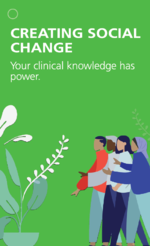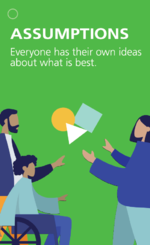Human Dimensions of Illness Experience: Difference between revisions
mNo edit summary |
No edit summary |
||
| Line 1: | Line 1: | ||
<div class="editorbox"> '''Original Editor '''- [[User:User Name|Rewan Elsayed Elkanafany]][[User:User Name|Kim Jackson]] '''Top Contributors''' - {{Special:Contributors/{{FULLPAGENAME}}}}</div> | <div class="editorbox"> '''Original Editor '''- [[User:User Name|Rewan Elsayed Elkanafany]][[User:User Name|Kim Jackson]] '''Top Contributors''' - {{Special:Contributors/{{FULLPAGENAME}}}}</div> | ||
== Introduction == | == Introduction == | ||
In order to help work towards the best lives for the people physiotherapists/physical therapists work with, it is essential the 'human' dimensions of illness and (dis)ability are taken into consideration. This is perhaps particularly the case when people seeking physio care have chronic, progressive conditions. The 'human' dimensions include the emotional<ref>Setchell, J., Abrams, T., McAdam, L., & Gibson, B. E. (2019). Cheer* in healthcare practice: What it excludes and why it matters. ''Qualitative health research, 29''(13), 1890-1903. doi:10.1177/1049732319838235</ref>, phenomenological<ref>Abrams, T., & Setchell, J. (2018). Living with death in rehabiliation: A phenomenological account. ''Human Studies, 41''(4), 677-695. </ref>, social, and moral<ref>Abrams, T., Setchell, J., Thille, P., Mistry, B., & Gibson, B. E. (2018). Affect, intensity, and moral assemblage in rehabilitation practice. ''Biosocieties, Online first''. [[doi:https://doi.org/10.1057/s41292-018-0115-2]]</ref> dimensions of illness experiences that combine and interact with the physical/biological dimensions. The human dimensions of illness experiences include factors such as dealing with disability stigma<ref>Setchell, J. (2017). What has stigma got to do with physiotherapy? ''Physiotherapy Canada, 69''(1), 1-4. </ref>, creating meaningful shortened lives, and managing family interactions.<ref name=":0">Setchell, J., Thille, P., Abrams, T., McAdam, L., Mistry, B., & Gibson, B. E. (2018). Enhancing the human aspects of care with young people with Muscular Dystrophy: Results from a participatory qualitative study with clinicians. ''Child: Health, Care and Development, 44''(2), 269-277. doi:doi:10.1111/cch.12526 </ref> | In order to help work towards the best lives for the people physiotherapists/physical therapists work with, it is essential the 'human' dimensions of illness and (dis)ability are taken into consideration. This is perhaps particularly the case when people seeking physio care have chronic, progressive conditions. The 'human' dimensions include the emotional<ref>Setchell, J., Abrams, T., McAdam, L., & Gibson, B. E. (2019). Cheer* in healthcare practice: What it excludes and why it matters. ''Qualitative health research, 29''(13), 1890-1903. doi:10.1177/1049732319838235</ref>, phenomenological<ref>Abrams, T., & Setchell, J. (2018). Living with death in rehabiliation: A phenomenological account. ''Human Studies, 41''(4), 677-695. </ref>, social, and moral<ref>Abrams, T., Setchell, J., Thille, P., Mistry, B., & Gibson, B. E. (2018). Affect, intensity, and moral assemblage in rehabilitation practice. ''Biosocieties, Online first''. [[doi:https://doi.org/10.1057/s41292-018-0115-2]]</ref> dimensions of illness experiences that combine and interact with the physical/biological dimensions. The human dimensions of illness experiences can include factors such as dealing with disability stigma<ref>Setchell, J. (2017). What has stigma got to do with physiotherapy? ''Physiotherapy Canada, 69''(1), 1-4. </ref>, creating meaningful shortened lives, and managing family interactions.<ref name=":0">Setchell, J., Thille, P., Abrams, T., McAdam, L., Mistry, B., & Gibson, B. E. (2018). Enhancing the human aspects of care with young people with Muscular Dystrophy: Results from a participatory qualitative study with clinicians. ''Child: Health, Care and Development, 44''(2), 269-277. doi:doi:10.1111/cch.12526 </ref> | ||
There is often a discrepancy between the importance clinicians place on the human aspects and what actually happens in the clinical setting<ref name=":0" />. Focusing on this aspect of care can improve outcomes for both the person with a disability and the clinician. It is not just the understanding between the clinician and the client that is important, understanding and communication within the multi-disciplinary team also has an impact on care. | There is often a discrepancy between the importance clinicians place on the human aspects and what actually happens in the clinical setting<ref name=":0" />. Focusing on this aspect of care can improve outcomes for both the person with a disability and the clinician. It is not just the understanding between the clinician and the client that is important, understanding and communication within the multi-disciplinary team also has an impact on care. | ||
Below are some tips to help health professionals think about the human dimensions of living with progressive disability. The tips are based on a set of cards called 'Cards for Humanity' which were an output from a 3-year project<ref>Setchell, J., Thille, P., Abrams, T., McAdam, L., Mistry, B., & Gibson, B. E. (2018). Enhancing the human aspects of care with young people with Muscular Dystrophy: Results from a participatory qualitative study with clinicians. ''Child: Health, Care and Development, 44''(2), 269-277. doi:doi:10.1111/cch.12526 </ref><ref>Setchell, J., McAdam, L., Abrams, T., Thille, P., Mistry, B., & Gibson, B. E. A realist evaluation of a project to enhance the human aspects of DMD care. ''Forthcoming''. </ref><ref>Thille, P., Gibson, B. E., Abrams, T., McAdam, L., Mistry, B., & Setchell, J. (2018). Enhancing the human dimensions of children's neuromuscular care: Piloting a methodology for fostering team reflexivity. ''Advances in Health Sciences Education, May 26''(1-23). </ref> investigating how clinicians did (or did not) attend to the human elements of living with muscular dystrophy. They were designed for clinicians working in children's neuromuscular outpatient settings but have been | |||
== Improving the Client/Clinician Experience == | == Improving the Client/Clinician Experience == | ||
| Line 13: | Line 13: | ||
=== Critical Reflexivity === | === Critical Reflexivity === | ||
[[File:CFH 9 Critical Reflexivity Front.png|right|frameless|246x246px]] | [[File:CFH 9 Critical Reflexivity Front.png|right|frameless|246x246px]] | ||
‘Critical reflexivity’ (as used here) refers to processes of examining the assumptions underlying clinical practice including “beliefs, values, social and systemic structures” and “how such dimensions influence our daily professional practice”<ref>Kinsella EA, Caty M, Ng S, Jenkins K. Reflective practice for allied health: Theory and applications. 2012. </ref>. There is an emphasis on considering the unintended assumptions and effects of any actions including how power operates through individual health practices, and broader systems of practice<ref>Setchell, J., & Dalziel, B. (2019). Using critical reflexivity to enhance clinical care: A clinian perspective. ''Journal of Humanities in Rehabilitation, May'', 1-12. </ref>. Critical reflexivity promotes change through challenging ingrained practices, roles and beliefs and values.<ref>Thille, P., Gibson, B. E., Abrams, T., McAdam, L., Mistry, B., & Setchell, J. (2018). Enhancing the human dimensions of children's neuromuscular care: Piloting a methodology for fostering team reflexivity. ''Advances in Health Sciences Education, May 26''(1-23). </ref><ref>Tremblay MC, Richard L, Brousselle A, Beaudet N. Learning reflexively from a health promotion professional development program in Canada. Health promotion international. 2014 Sep 1;29(3):538-48. | |||
</ref> | </ref> | ||
* Reflexivity often requires time, space and facilitation. | * Reflexivity often requires time, space and facilitation. | ||
* | * Clinicians need to create time to think about the human aspects of care. | ||
* Both team and individual reflexivity is needed. | * Both team and individual reflexivity is needed. | ||
* Think about how clinical care can address the emotional, social and personal aspects of clients' lives. | * Think about how clinical care can address the emotional, social and personal aspects of clients' lives. | ||
Revision as of 01:18, 28 November 2019
Introduction[edit | edit source]
In order to help work towards the best lives for the people physiotherapists/physical therapists work with, it is essential the 'human' dimensions of illness and (dis)ability are taken into consideration. This is perhaps particularly the case when people seeking physio care have chronic, progressive conditions. The 'human' dimensions include the emotional[1], phenomenological[2], social, and moral[3] dimensions of illness experiences that combine and interact with the physical/biological dimensions. The human dimensions of illness experiences can include factors such as dealing with disability stigma[4], creating meaningful shortened lives, and managing family interactions.[5]
There is often a discrepancy between the importance clinicians place on the human aspects and what actually happens in the clinical setting[5]. Focusing on this aspect of care can improve outcomes for both the person with a disability and the clinician. It is not just the understanding between the clinician and the client that is important, understanding and communication within the multi-disciplinary team also has an impact on care.
Below are some tips to help health professionals think about the human dimensions of living with progressive disability. The tips are based on a set of cards called 'Cards for Humanity' which were an output from a 3-year project[6][7][8] investigating how clinicians did (or did not) attend to the human elements of living with muscular dystrophy. They were designed for clinicians working in children's neuromuscular outpatient settings but have been
Improving the Client/Clinician Experience[edit | edit source]
There are often topics that are difficult to address, especially between cultures, genders and social class but they are a necessary part of treatment. By finding ways to explore these topics and give the client and their families more control over what is discussed and how can improve trust and care creating a more open and honest environment. People come from all different walks of life and backgrounds and our own assumptions about right and wrong, good and bad can impact our views of those we are caring for. It is important that we do not force our assumptions, values, actions and beliefs on others.
Critical Reflexivity[edit | edit source]
‘Critical reflexivity’ (as used here) refers to processes of examining the assumptions underlying clinical practice including “beliefs, values, social and systemic structures” and “how such dimensions influence our daily professional practice”[9]. There is an emphasis on considering the unintended assumptions and effects of any actions including how power operates through individual health practices, and broader systems of practice[10]. Critical reflexivity promotes change through challenging ingrained practices, roles and beliefs and values.[11][12]
- Reflexivity often requires time, space and facilitation.
- Clinicians need to create time to think about the human aspects of care.
- Both team and individual reflexivity is needed.
- Think about how clinical care can address the emotional, social and personal aspects of clients' lives.
Facilitating Change[edit | edit source]
- The burden of change often falls on clients/families.
- As a clinician, your voice has power.
- Important areas for change include:
- reducing disability stigma
- improved accessibility
- better service availability
Choosing the Right Language[edit | edit source]
Language has power and by acknowledging that you can improve the client’s experience and help to build a stronger connection. Misunderstandings, bias or feelings of not being heard can negatively impact on a client and how they openly and honestly they respond to their clinicians.
Improving the MDT Experience[edit | edit source]
Although each member of the MDT has the Client’s interest at the core of their care each clinician’s perspective will be different but all equally important. Finding ways to see the client from another perspective can help not only unity within the team but also a more client centred approach to management and care. By having an all-round view of a client’s needs from all members of the team can remove unnecessary assumptions which in turn results in clear, appropriate short and long term goals making it easier to streamline services and set effective timelines. Also by working in a more open and receptive environment can benefit the individual’s involved in a client’s care whether that is the clinicians, the family or care givers. It is important to feel part of team and to be able to ask for assistance if you need it. To be an effective care giver you also need to be able to seek support when needed.
Improving the Clinic Experience[edit | edit source]
- Flexibility
- Facilitate input from the clients and families.
- Balance 'best practice' care with individual family priorities.
- Be open to changing clinic routines.
- Foster creative solutions
Learning New Skills – Upskilling[edit | edit source]
Enhance the human aspects of client and family lives by improving understanding of:
- diversity and inclusion
- spirituality, meaning making, religion
- addressing and supporting 'negative' emotions
- self-care for clinicians
- coping with client death and decline
- sexuality and disability
Conclusion[edit | edit source]
In order to ensure that the client's experience meets their needs it is necessary to balance medical and human care. This can be achieved at looking at how we currently deliver healthcare in a different way. Examples of this can mean a totally different approach to our interaction with our clients. Some points to consider:
- Avoid sidelining 'human' aspects such as the emotional, personal, moral.
- Are routine assessments always needed?
- Create procedures to ensure 'human' aspects are considered and addressed.
Resources[edit | edit source]
Cards for Humanity - Download PDF
References[edit | edit source]
- ↑ Setchell, J., Abrams, T., McAdam, L., & Gibson, B. E. (2019). Cheer* in healthcare practice: What it excludes and why it matters. Qualitative health research, 29(13), 1890-1903. doi:10.1177/1049732319838235
- ↑ Abrams, T., & Setchell, J. (2018). Living with death in rehabiliation: A phenomenological account. Human Studies, 41(4), 677-695.
- ↑ Abrams, T., Setchell, J., Thille, P., Mistry, B., & Gibson, B. E. (2018). Affect, intensity, and moral assemblage in rehabilitation practice. Biosocieties, Online first. doi:https://doi.org/10.1057/s41292-018-0115-2
- ↑ Setchell, J. (2017). What has stigma got to do with physiotherapy? Physiotherapy Canada, 69(1), 1-4.
- ↑ 5.0 5.1 Setchell, J., Thille, P., Abrams, T., McAdam, L., Mistry, B., & Gibson, B. E. (2018). Enhancing the human aspects of care with young people with Muscular Dystrophy: Results from a participatory qualitative study with clinicians. Child: Health, Care and Development, 44(2), 269-277. doi:doi:10.1111/cch.12526
- ↑ Setchell, J., Thille, P., Abrams, T., McAdam, L., Mistry, B., & Gibson, B. E. (2018). Enhancing the human aspects of care with young people with Muscular Dystrophy: Results from a participatory qualitative study with clinicians. Child: Health, Care and Development, 44(2), 269-277. doi:doi:10.1111/cch.12526
- ↑ Setchell, J., McAdam, L., Abrams, T., Thille, P., Mistry, B., & Gibson, B. E. A realist evaluation of a project to enhance the human aspects of DMD care. Forthcoming.
- ↑ Thille, P., Gibson, B. E., Abrams, T., McAdam, L., Mistry, B., & Setchell, J. (2018). Enhancing the human dimensions of children's neuromuscular care: Piloting a methodology for fostering team reflexivity. Advances in Health Sciences Education, May 26(1-23).
- ↑ Kinsella EA, Caty M, Ng S, Jenkins K. Reflective practice for allied health: Theory and applications. 2012.
- ↑ Setchell, J., & Dalziel, B. (2019). Using critical reflexivity to enhance clinical care: A clinian perspective. Journal of Humanities in Rehabilitation, May, 1-12.
- ↑ Thille, P., Gibson, B. E., Abrams, T., McAdam, L., Mistry, B., & Setchell, J. (2018). Enhancing the human dimensions of children's neuromuscular care: Piloting a methodology for fostering team reflexivity. Advances in Health Sciences Education, May 26(1-23).
- ↑ Tremblay MC, Richard L, Brousselle A, Beaudet N. Learning reflexively from a health promotion professional development program in Canada. Health promotion international. 2014 Sep 1;29(3):538-48.











